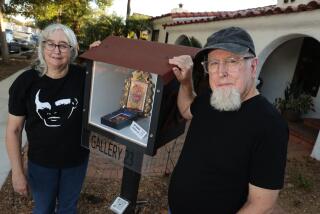2 Museums Might Have Bought Outerbridge Works
- Share via
LAGUNA BEACH — Photography experts at two major Southern California art institutions said Thursday that had they known Laguna Art Museum was considering selling off its collection of 93 works by Paul Outerbridge, they would have tried to buy it.
Instead, the head of the Los Angeles County Museum of Art’s photography department and the director of the Museum of Photographic Arts in San Diego said they were completely unaware that Outerbridge’s Modernist photos, drawings and lithographs, considered a linchpin of Laguna’s permanent collection, were available.
On Wednesday, Laguna officials revealed that following a lengthy and unsuccessful search to find a buyer for the whole collection, they have consigned the works to be auctioned off piece by piece later this year by Christie’s in New York. The museum will use the proceeds to buy other “significant pieces” for its permanent collection.
“It’s a terrible move to make, regardless of what they intended to do with the funds,” said Arthur Ollman at the San Diego museum. “They were sitting on an extremely important grouping of one of Southern California’s most important artists and one that is intimately connected--as a [longtime] resident--with their community.”
*
The Outerbridge collection “has every characteristic that a museum wants in their collection: A world-famous artist, extremely important work, a large, round[ed] collection of the material . . . and perfect provenance because it came from the widow.
“[My institution] was not approached [as a possible buyer of the collection], nor was I aware it was on the market. I would have approached my board and asked if they were interested or able to locate money in the community to do it.
“Whether we could have been successful, I don’t know,” Ollman said. “But we have seen other important photography collections even nearer to us than Laguna be sold off and disbursed around the country, denying our local communities their patrimony.”
Ollman suggested Laguna officials could have found a private donor to buy the collection and donate it to another institution in the area, thereby helping both institutions and giving the donor a tax benefit.
*
Similarly, LACMA’s Robert A. Sobieszek said: “I would have gone to bat to raise the funds to buy the whole thing, or made a deal to keep it together. . . . It would have made absolute perfect sense in the collection we’re trying to build here.
“It seems that museum is not noted for much in the museum world except for the Outerbridge collection and for doing some remarkable exhibitions,” Sobieszek said. “I think it is one of their principal holdings.
“What I’m dismayed by is that I don’t think a really good effort to keep the collection [together] was made,” he said.
“It represents classic work [Outerbridge] made before he moved here. . . . He was one of the great pioneers of Cubist photography and commercial Modernism. You had a core group that can’t be duplicated in any other institution, not even the Getty. . . . As far as a body of works of art, this is nonpareil.”
Terence Pitts, director of the Center for Creative Photography at the University of Arizona at Tucson, also had no idea the collection was for sale. He said the fact that the collection “came from [Outerbridge’s] widow as a single gift, as opposed to something accumulated over the years from numerous sources . . . argues both for keeping it there [at the Laguna Art Museum] and keeping it together.”
*
In contrast, Jonathan Green, director of California Museum of Photography at UC Riverside, said he was “not totally shocked or unsympathetic to an institution trying to define its character in new directions.”
“It would certainly serve scholarship and research the most if a significant collection like that would remain intact so students, scholars and the general public would have the opportunity to look at it in context,” he said.
“[But] my sense is that some of the ground rules that have been a part of museum culture, particularly in last half of the century, are going to have to change from a practical and utilitarian point of view,” Green said. “Museums are in a very difficult age of uncertainty in terms of their very existence. . . . I would think the crisis in funding is going to cause many institutions to review traditional and accepted practices.”
Bolton Colburn, chief curator at the Laguna Art Museum, said his institution “exercised every available avenue it could take,” including making additional efforts to find a home for the collection after the contract of the museum’s agent, San Francisco dealer Jeffrey Fraenkel, had expired.
The search continued, Colburn said, “up to the point where it was not beneficial for the museum to pursue it any further.”
More to Read
The biggest entertainment stories
Get our big stories about Hollywood, film, television, music, arts, culture and more right in your inbox as soon as they publish.
You may occasionally receive promotional content from the Los Angeles Times.










